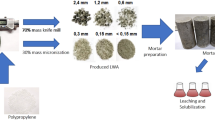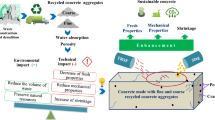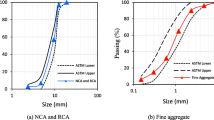Abstract
Leather production is a technology that boosts the economy because of its versatility and durability. However, the wastes generated throughout the process are categorized as toxic due to the high chrome concentration. In this work, the effects caused by the incorporation of leather shavings (wet blue) on the mechanical and physical properties of the concrete composite and the possibility of neutralizing the chrome's toxicity are evaluated. Namely, the leather shavings partially replace natural aggregates. In order to characterize the mechanical, physical, and morphological properties of the concretes, 7, 14, and 28 days-aged samples were evaluated. A leaching test is also performed to determine the efficiency of chromium encapsulation in the cement matrix. The experiments present that the workability of concrete decreases as the leather shavings content increases. We add a superplasticizer additive was to make the concrete workable, but a decrement in the mechanical properties similar to the samples without additive, is noted. With respect to the physical properties, the reduction of water permeability indicates a more durable material. Experimental findings highlight the ability to use the concrete with leather shavings as an alternative construction material.
Highlights
-
Reuse of leather tannery waste “wet blue” as a partial replacement for natural sand was studied.
-
New concrete for sidewalk was produced.
-
Concrete with leather waste has a higher porosity and permeability, with lower compressive strength.
-
Utilization of leather waste meets Brazilian Standards for application as sidewalk.
-
Reuse of industrial waste reduces landfill disposal and the use of natural resources.





Similar content being viewed by others
Data availability
No data was used for the research described in the article.
References
Modro NLRNR, Modro NLRNR, Modro NLRNR, Oliveira APN (2009) Avaliação de concreto de cimento Portland contendo resíduos de PET. Matéria (Rio Janeiro) 14:725–736. https://doi.org/10.1590/S1517-70762009000100007
Kachouh N, El-Hassan H, El-Maaddawy T (2019) Effect of steel fibers on the performance of concrete made with recycled concrete aggregates and dune sand. Constr Build Mater 213:348–359. https://doi.org/10.1016/j.conbuildmat.2019.04.087
Liu Z, Cai CS, Peng H, Fan F (2016) Experimental study of the geopolymeric recycled aggregate concrete. J Mater Civ Eng 28:04016077. https://doi.org/10.1061/(ASCE)MT.1943-5533.0001584
Urrego Yepes W, Cardona N, Velasquez SM et al (2019) Mechanical and rheometric properties of natural rubber composites filled with untreated and chemically treated leather wastes. J Compos Mater 53:1475–1487. https://doi.org/10.1177/0021998318805195
Mendes VRV, Sant’ana Alvarenga R de CS, da Silva CL, et al (2015) Evaluation of Incorporation of a Leather Waste Powder in Mortars for Construction Industry. Mater Sci Forum 820:558–563. https://doi.org/10.4028/www.scientific.net/MSF.820.558
Ribeiro DV, Yuan SY, Morelli MR (2012) Influence of addition of chemically treated leather shaving in the portland cement mortars characteristics. Mater Sci Forum 727–728:1402–1407. https://doi.org/10.4028/www.scientific.net/MSF.727-728.1402
Bini C, Maleci L, Romanin A (2008) The chromium issue in soils of the leather tannery district in Italy. J Geochemical Explor 96:194–202. https://doi.org/10.1016/j.gexplo.2007.03.008
Barbanera M, Belloni E, Buratti C et al (2020) Recycled leather cutting waste-based boards: thermal, acoustic, hygrothermal and ignitability properties. J Mater Cycles Waste Manag 22:1339–1351. https://doi.org/10.1007/s10163-020-01024-3
Binici H, Aksogan O (2015) Engineering properties of insulation material made with cotton waste and fly ash. J Mater Cycles Waste Manag 17:157–162. https://doi.org/10.1007/s10163-013-0218-6
Santos RJ, Agostini DLS, Cabrera FC et al (2015) Recycling leather waste: Preparing and studying on the microstructure, mechanical, and rheological properties of leather waste/rubber composite. Polym Compos 36:2275–2281. https://doi.org/10.1002/pc.23140
Aguiar JB, Valente A, Pires MJ, Tavares T (2001) Incorporation feasibility of leather residues in bricks. Key Eng Mater 206–213:2005–2008. https://doi.org/10.4028/www.scientific.net/KEM.206-213.2005
Lakrafli H, Tahiri S, Albizane A, El Otmani ME (2012) Effect of wet blue chrome shaving and buffing dust of leather industry on the thermal conductivity of cement and plaster based materials. Constr Build Mater 30:590–596. https://doi.org/10.1016/j.conbuildmat.2011.12.041
Lakrafli H, Tahiri S, Albizane A et al (2013) Experimental study of thermal conductivity of leather and carpentry wastes. Constr Build Mater 48:566–574. https://doi.org/10.1016/j.conbuildmat.2013.07.048
Lakrafli H, Tahiri S, Albizane A et al (2017) Effect of thermal insulation using leather and carpentry wastes on thermal comfort and energy consumption in a residential building. Energy Effic 10:1189–1199. https://doi.org/10.1007/s12053-017-9513-8
Amiandamhen SO, OsadolorOsadolor OSO (2020) Recycled waste paper–cement composite panels reinforced with kenaf fibres: durability and mechanical properties. J Mater Cycles Waste Manag 22:1492–1500. https://doi.org/10.1007/s10163-020-01041-2
Djelal C, Page J, Kada H, Vanhove Y (2020) Feasibility study of using poplar wastes as sand in cement mortars. J Mater Cycles Waste Manag 22:488–500. https://doi.org/10.1007/s10163-019-00946-x
Ribeiro B, Yamashiki Y (2020) A study on mechanical properties of mortar with sugarcane bagasse fiber and bagasse ash. J Mater Cycles Waste Manag 22:1844–1851. https://doi.org/10.1007/s10163-020-01071-w
Khan M, Rehman A, Ali M (2020) Efficiency of silica-fume content in plain and natural fiber reinforced concrete for concrete road. Constr Build Mater 244:118382. https://doi.org/10.1016/j.conbuildmat.2020.118382
Krishna NK, Prasanth M, Gowtham R et al (2018) Enhancement of properties of concrete using natural fibers. Mater Today Proc 5:23816–23823. https://doi.org/10.1016/j.matpr.2018.10.173
Rahman N, Shing LW, Simon L et al (2017) Enhanced bamboo composite with protective coating for structural concrete application. Energy Procedia 143:167–172. https://doi.org/10.1016/j.egypro.2017.12.666
Dávila-Pompermayer R, Lopez-Yepez LG, Valdez-Tamez P et al (2020) Lechugilla natural fiber as internal curing agent in self compacting concrete (SCC): Mechanical properties, shrinkage and durability. Cem Concr Compos. https://doi.org/10.1016/j.cemconcomp.2020.103686
Kumar P, Roy R (2018) Study and experimental investigation of flow and flexural properties of natural fiber reinforced self compacting concrete. Procedia Comput Sci 125:598–608. https://doi.org/10.1016/j.procs.2017.12.077
Wei J, Meyer C (2016) Utilization of rice husk ash in green natural fiber-reinforced cement composites: Mitigating degradation of sisal fiber. Cem Concr Res 81:94–111. https://doi.org/10.1016/j.cemconres.2015.12.001
Khan M, Ali M (2016) Use of glass and nylon fibers in concrete for controlling early age micro cracking in bridge decks. Constr Build Mater 125:800–808. https://doi.org/10.1016/j.conbuildmat.2016.08.111
Lee S (2019) Effect of nylon fiber addition on the performance of recycled aggregate concrete. Appl Sci 9:767. https://doi.org/10.3390/app9040767
Orasutthikul S, Unno D, Yokota H (2017) Effectiveness of recycled nylon fiber from waste fishing net with respect to fiber reinforced mortar. Constr Build Mater 146:594–602. https://doi.org/10.1016/j.conbuildmat.2017.04.134
Mohammadhosseini H, Abdul Awal ASM, Mohd Yatim JB (2017) The impact resistance and mechanical properties of concrete reinforced with waste polypropylene carpet fibres. Constr Build Mater 143:147–157. https://doi.org/10.1016/j.conbuildmat.2017.03.109
Mohammadhosseini H, Yatim JM (2017) Microstructure and residual properties of green concrete composites incorporating waste carpet fibers and palm oil fuel ash at elevated temperatures. J Clean Prod 144:8–21. https://doi.org/10.1016/j.jclepro.2016.12.168
Pereira EL, de Oliveira Junior AL, Fineza AG (2017) Optimization of mechanical properties in concrete reinforced with fibers from solid urban wastes (PET bottles) for the production of ecological concrete. Constr Build Mater 149:837–848. https://doi.org/10.1016/j.conbuildmat.2017.05.148
Hesami S, Salehi Hikouei I, Emadi SAA (2016) Mechanical behavior of self-compacting concrete pavements incorporating recycled tire rubber crumb and reinforced with polypropylene fiber. J Clean Prod 133:228–234. https://doi.org/10.1016/j.jclepro.2016.04.079
Ataei H (2016) Experimental study of rubber tire aggregates effect on compressive and dynamic load-bearing properties of cylindrical concrete specimens. J Mater Cycles Waste Manag 18:665–676. https://doi.org/10.1007/s10163-015-0362-2
Chai L, Guo L, Chen B et al (2019) Mechanical properties of ecological high ductility cementitious composites produced with recycled crumb rubber and recycled asphalt concrete. J Mater Cycles Waste Manag 21:488–502. https://doi.org/10.1007/s10163-018-0813-7
Qin Y, Zhang X, Chai J et al (2019) Experimental study of compressive behavior of polypropylene-fiber-reinforced and polypropylene-fiber-fabric-reinforced concrete. Constr Build Mater 194:216–225. https://doi.org/10.1016/j.conbuildmat.2018.11.042
Ranjbar N, Talebian S, Mehrali M et al (2016) Mechanisms of interfacial bond in steel and polypropylene fiber reinforced geopolymer composites. Compos Sci Technol 122:73–81. https://doi.org/10.1016/j.compscitech.2015.11.009
Patnaik B, Bhojaraju C, Mousavi SS (2020) Experimental study on residual properties of thermally damaged steel fiber-reinforced concrete containing copper slag as fine aggregate. J Mater Cycles Waste Manag 22:801–815. https://doi.org/10.1007/s10163-020-00972-0
Rostami R, Zarrebini M, Mandegari M et al (2019) The effect of concrete alkalinity on behavior of reinforcing polyester and polypropylene fibers with similar properties. Cem Concr Compos 97:118–124. https://doi.org/10.1016/j.cemconcomp.2018.12.012
NBR 16697 (2018) Portland cement - Requirements. Rio de Janeiro, Brazil
Cabral AEB, Schalch V, Dal Molin DCC et al (2009) Desempenho de concretos com agregados reciclados de cerâmica vermelha. Cerâmica 55:448–460. https://doi.org/10.1590/S0366-69132009000400016
ABNT NBR 6118:2014 (2014) Design of concrete structures — Procedure. Rio de Janeiro, Brazil
Khan MA, Khan RA, Aliya BS, Islam MN (2002) Modification of wet blue leather surface by photo-curing with urethane acrylate containing dye. J Macromol Sci Part A 39:22
Parlato MCM, Porto SMC (2020) Organized framework of main possible applications of sheep wool fibers in building components. Sustainability 12:761. https://doi.org/10.3390/su12030761
NBR 5738:2016 (2016) Concrete - Procedure for molding and curing concrete test specimens. Rio de Janeiro, Brazil, Brazil
NM 67:1998 (1998) Concrete - Slump test for determination of the consistency. Rio de Janeiro, Brazil
ASTM C143/C143M-15a (2015) Standard Test Method for Slump of Hydraulic-Cement Concrete. West Conshohocken, PA
NBR 5739:2018 (2018) Concrete - Compression test of cylindrical specimens. Rio de Janeiro, Brazil
ASTM C39/C39M-20 (2020) Standard Test Method for Compressive Strength of Cylindrical Concrete Specimens. West Conshohocken, PA
NBR 7222:2011 (2011) Concrete and mortar - Determination of the tension strength by diametrical compression of cylindrical test specimens. Rio de Janeiro, Brazil, Brazil
NBR 9778 (2009) Hardened mortar and concrete - Determination of absorption, voids and specific gravity. Rio de Janeiro, Brazil
ASTM C642-13 (2013) Standard Test Method for Density, Absorption, and Voids in Hardened Concrete. West Conshohocken, PA
ABNT NBR ISO 5398-3 (2014) Leather – Chemical determination of chromic oxide content Part 3: Quantification by atomic absorption spectrometry. Rio de Janeiro, Brazil
NBR 10005:2004 (2004) procedure for obtention leaching extract of solid wastes. Rio de Janeiro, Brazil
de Oliveira JPJ, Hiranobe CT, Torres GB et al (2022) Determination of Cr(VI) in leather residues using graphite/paraffin composite electrodes modified with reduced graphene oxide nanosheets. Sci Total Environ 834:155318. https://doi.org/10.1016/j.scitotenv.2022.155318
Foti D (2011) Preliminary analysis of concrete reinforced with waste bottles PET fibers. Constr Build Mater 25:1906–1915. https://doi.org/10.1016/j.conbuildmat.2010.11.066
Alyousef R, Alabduljabbar H, Mohammadhosseini H et al (2020) Utilization of sheep wool as potential fibrous materials in the production of concrete composites. J Build Eng 30:101216. https://doi.org/10.1016/j.jobe.2020.101216
Mohammadhosseini H, Yatim JM, Sam ARM, Awal ASMA (2017) Durability performance of green concrete composites containing waste carpet fibers and palm oil fuel ash. J Clean Prod 144:448–458. https://doi.org/10.1016/j.jclepro.2016.12.151
Borges APSN, de Motta LA, C, Pinto EB, (2019) Study of concrete properties with vegetal and polypropylene fibers for use in structural walls. Matéria. https://doi.org/10.1590/s1517-707620190002.0679
Awal ASMA, Mohammadhosseini H (2016) Green concrete production incorporating waste carpet fiber and palm oil fuel ash. J Clean Prod 137:157–166. https://doi.org/10.1016/j.jclepro.2016.06.162
Meddah MS, Bencheikh M (2009) Properties of concrete reinforced with different kinds of industrial waste fibre materials. Constr Build Mater 23:3196–3205. https://doi.org/10.1016/j.conbuildmat.2009.06.017
Brandt AM (2008) Fibre reinforced cement-based (FRC) composites after over 40 years of development in building and civil engineering. Compos Struct 86:3–9. https://doi.org/10.1016/j.compstruct.2008.03.006
Freitas C, Galvão JCA, Portella KF et al (2009) Physicochemical and mechanical performance of portland cement concrete with recycled styrene-butadiene tyre-rubber waste. Quim Nova 32:913–918. https://doi.org/10.1590/S0100-40422009000400016
Amaral Júnior JC, do, Silva LCF, Moravia WG, (2017) Experimental analyses of polymeric fiber addition on concrete mechanical properties. Matéria. https://doi.org/10.1590/s1517-707620170001.0112
NBR 10004 (2004) Solid waste – Classification. Rio de Janeiro, Brazil
Acknowledgements
The authors would to like to thank the support of “UNOESTE—Universidade do Oeste Paulista”, providing the Civil Engineering laboratory for the technological tests to be carried out, and Gabriel Mamoru Marques Shinohara of the Chemical Laboratory at “UNESP—Universidade Estadual Paulista” in Presidente Prudente for leaching tests. The concrete for application was financed by Curtume Touro LTDA of Presidente Prudente to manufacture the FCT Waste Laboratory's sidewalks—Presidente Prudente. This study was financed in part by the Coordenação de Aperfeiçoamento de Pessoal de Nível Superior—Brasil (CAPES) —Finance Code 001.
Author information
Authors and Affiliations
Corresponding author
Additional information
Publisher's Note
Springer Nature remains neutral with regard to jurisdictional claims in published maps and institutional affiliations.
Rights and permissions
Springer Nature or its licensor (e.g. a society or other partner) holds exclusive rights to this article under a publishing agreement with the author(s) or other rightsholder(s); author self-archiving of the accepted manuscript version of this article is solely governed by the terms of such publishing agreement and applicable law.
About this article
Cite this article
Canhada, J.C.S., Paiva, F.F.G., Shinohara, G.M.M. et al. Production of new concrete with leather tannery waste used as partial replacement of the natural sand. J Mater Cycles Waste Manag 25, 944–953 (2023). https://doi.org/10.1007/s10163-022-01586-4
Received:
Accepted:
Published:
Issue Date:
DOI: https://doi.org/10.1007/s10163-022-01586-4




